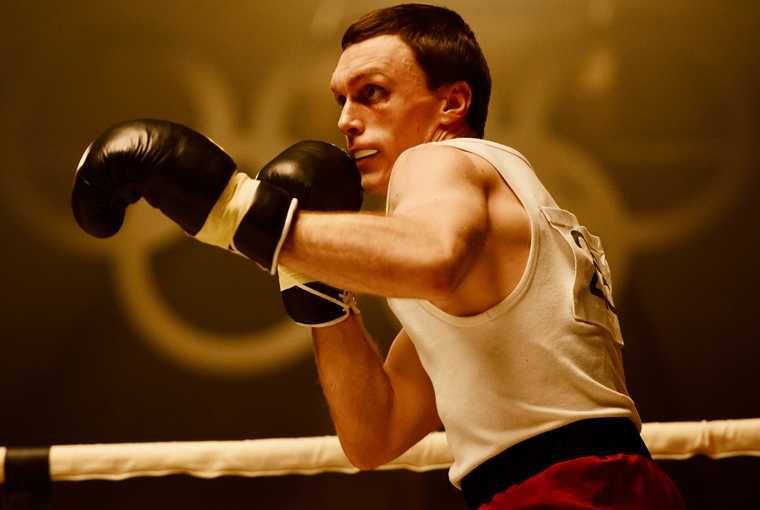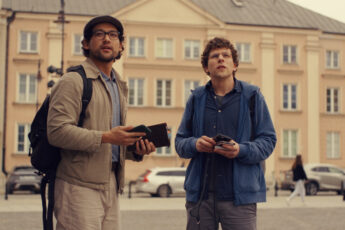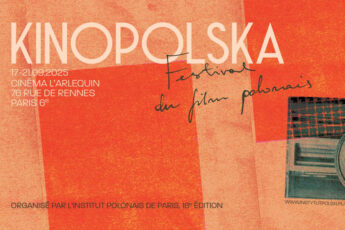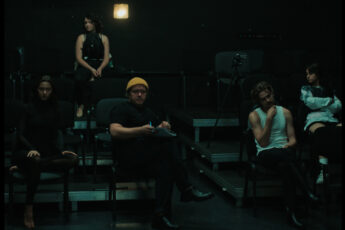State Bodies
James Napier Robertson’s The American (Joika, 2023) & Xawery Żuławski’s Kulej. All That Glitters Isn’t Gold (Kulej. Dwie Strony Medalu, 2024)
Vol. 156 (Summer 2025) by Moritz Pfeifer
After 1989, Polish filmmakers revisited history to redefine Poland’s identity in the post-Communist era. A current within Polish cinema constructed heroic-martyrological historical narratives. For example, Andrzej Wajda’s Katyń (2007) memorialized the massacre of Polish officers and intellectuals as a sacred national wound, reinforcing Poland’s image as a martyred nation. His later Wałęsa: Man of Hope (Wałęsa. Człowiek z nadziei, 2013) mythologized the Solidarność leader as the embodiment of national sovereignty and resilience. Together, the war film and the biopic exemplify dozens, if not hundreds, of post-Communist Polish films that turn to history to construct a new national consciousness rooted in concepts of victimhood, sovereignty, and cultural homogeneity. As we discuss in this month’s editorial, the most-watched Polish films of 2024 remain within these two film genres. Newer films, however, have shifted towards a more aggressive, authoritarian vision.
This can be seen in two recent films co-produced by the Polish Film Institute: James Napier Robertson’s The American (Joika) and Xawery Żuławski’s Kulej. All That Glitters Isn’t Gold (Kulej. Dwie strony medalu), which construct two contrasting modes of Polish national identity for contemporary audiences. Joika, a transnational co-production, defines this identity through external conflict. The film uses a war-film aesthetic to portray Russia as a geopolitical antagonist. Kulej, a domestic heritage film, uses a polished, glossy aesthetic to reframe a contentious historical period as one of ultimate harmony and uncomplicated heroism. The respective cinematographic choices are the primary carrier of each film’s ideological project. Joika adopts a visual language rooted in the legacy of Second World War films to tell a story about the first American ballerina accepted into the Bolshoi. The biopic on two-time Olympic gold boxer Jerzy Kulej uses a sleek, commercial aesthetic to sanitize Poland under Communism.
“Joika” and the Aesthetics of Combat
Joika tells the story of American ballerina Joy Womack (Talia Ryder), the first US dancer to sign a contract with the Bolshoi Ballet. It follows her brutal training under Tatiyana Volkova (Diane Kruger) as the young dancer tries to survive the corruption and harsh discipline of Moscow’s ballet world. The film’s aesthetic is defined by a muted color palette that evokes the desaturated, high-contrast look of combat films. At least since Steven Spielberg’s Saving Private Ryan (1998), the bleach bypass process, which crushes blacks and washes out colors, has become the preferred aesthetic to depict war. Cinematographer Tomasz Naumiuk’s filmography includes the TV war dramas The Border (Wataha, 2014) and The Passing Bells (Dzwony wojny, 2014) and Agnieszka Holland’s Mr. Jones (2019), all of which use a similar monochromatic scale. In Joika, the cinematography associates the aesthetics of Polish trauma and resistance to what, on the surface, is a non-Polish story about a ballerina in Moscow.
At the Bolshoi, Joy faces a system of corruption, cruelty, and anti-Western sentiment. It is easy for audiences to understand Joy’s individual struggle in terms of national antagonisms. Characters in the film repeatedly explain the obstacles she faces by stating, “this is Russia,” turning her private battle into a national one. Western individualism, meritocracy, and cultural openness are pitted against cronyism and insularity. The film’s decisive battle is staged during Joy’s final performance at the Varna International Ballet Competition, in which she injures her ankle during a pas de deux, and then continues the choreography by herself, winning the prize. The wound liberates her from the Russian collective and allows for the creation of a purely individualistic narrative, a triumph that is achieved, importantly, through pain. The cinematography, which throughout the story aestheticized bleeding toes and bruised skin, turns her endurance into public spectacle.
The aestheticizing of Joy’s pain becomes the physical manifestation of necessary destruction, leading to a personal rebirth, a core idea of the ideology of palingenesis.1 Here, the film betrays its own purported values: it criticizes Russian society but substitutes merit with an inspirational Übermensch whose value derives from the display of suffering. The film offers no critique of the broader power structure; it celebrates individual success while the oppressive system remains intact. All of this fits in neatly with a Polish self-image that has long relied on sacrifice and confrontation with hostile outsiders, but in Joika it acquires a more authoritarian edge. The film demands that the individual be broken down and violently purged of all weakness. This glorification of personal annihilation for a perceived greater good is precisely how fascism justifies sacrificing people for the abstract ideal of the reborn state.
“Kulej” and the Aesthetics of Dance
The so-called “Ostalgie” films that were popular in Germany in the late 1990s and early 2000s celebrate everyday life during Communism and use humor or warmth to revisit the past. In these films, ordinary people and family dramas are central, even as they nod at the regime’s brutality. The films functioned as a form of counter-memory. They acknowledged personal and collective memories in the face of a historical narrative that focuses almost exclusively on state oppression. While some of these films may feel apologetic, they are important correctives to both the idea that society under Communism was politically immature throughout, and to the political instrumentalization of the past to justify policies that can be considered to run counter to most people’s interests in the present. In short, they are anti-authoritarian, as they consistently privilege the integrity of individual experience over the totalizing claims of state ideology. Kulej borrows from the aesthetics of these films but turns the anti-authoritarian premise on its head. Instead of critical humanism, it offers a monumentalist biopic of celebrity boxer Jerzy Kulej (Tomasz Włosk) as a national icon and a poster boy for the state.
The director’s stated goal was to find “colorful and passionate people” within the “grey and sad times” of the era.2 And so Kulej is glossily shot. Many scenes, even outside the boxing ring, light characters for spectacle. If Joika turned dance into combat, Kulej transforms boxing into dance. The fight sequences are filmed in slow-motion and with a focus on graceful form. The scenes in the ring are frequently juxtaposed with scenes of actual dancing at ballrooms and private parties, which are part of the film’s vibrant depiction of 1960s social life. In Ostalgie cinema, domestic life is the refuge, the space where “hidden transcripts,” to borrow James C. Scott’s vocabulary, resist “public transcripts.”3 In Kulej, the dance around the kitchen table is lit and choreographed just like the ballroom, which is lit and choreographed just like the boxing ring. Private life is aestheticized into a public performance, erasing an important reality of Communist experience.
Early on, Kulej negotiates with Colonel Sikorski (Tomasz Kot) to be handed an upscale apartment in return for helping the government for propaganda purposes. The deal is filmed as a power play with the colonel sitting in uniform behind his desk in a Communist-era mise-en-scène. The film presents the transaction as pragmatic: individual success is achieved through collaboration with state power. Kulej’s personal ambition (to provide a better life for his family) is met by the state’s political ambition (to use a popular hero for propaganda purposes). And so Kulej’s life becomes public property. Unlike the protagonists of the “cinema of moral anxiety” of the 1970s that explored the conflict between personal integrity and a stifling political environment, Kulej is not depicted as a man wrestling with moral compromise. Instead, the narrative treats his co-optation by the state with a weird indulgent levity that neuters the stakes. By the end of the film, even Sikorski is reframed as an ally in the national project of winning Olympic gold.
The glorification of the idealized body as a symbol of power is a central element of an authoritarian aesthetic. During fascism, the pursuit of a perfect physical form was intertwined with eugenics and racial theories that defined this ideal against alien or “decadent” influences, such as jazz.4 The perfected individual body was then meant to be subsumed into a greater collective, a communal body that moved in unison, mirroring the totalitarian ideal of a society conforming to the will of a single leader. This created a visual metaphor for the fascist state: a mass of disciplined, purified bodies performing their unity and strength as a national spectacle. In both Joika and Kulej, dance functions as a form through which the state, or the idea of the state, is staged. Joika’s body must be violently purged of weakness in a process that mirrors the fascist concept of palingenesis, or national rebirth through destruction. Kulej dissolves the private into the public through a choreography that equates family life, ballroom gaiety, and the boxing ring as interchangeable sites of national glory. Their shared choreography of pain and triumph are signs of an authoritarian turn in Polish cinema. The martyred nation of Wajda’s cinema gives way to a triumphant one, where personal sacrifice is not a historical tragedy but a wilful act of self-consecration.
- Griffin, R. (1991). The nature of fascism. Pinter Publishers. ↩︎
- Salwa, O. (2024, May 28). Xavery Żuławski’s boxer biopic Kulej in post-production. Cineuropa. https://cineuropa.org/en/newsdetail/455793/ ↩︎
- Scott, J. C. (1990). Domination and the arts of resistance: Hidden transcripts. Yale University Press. ↩︎
- Macintosh, F. (2023). Moving images, moving bodies: Greek dance, eugenics and fascism. Fascism, 12(2), 206–227. ↩︎




Leave a Comment